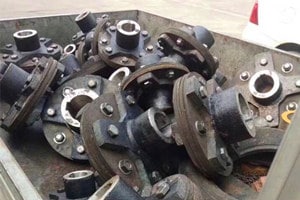
The process of die cutting is much like making cookies using cookie cutters. The material, either in sheet or strip form, is fed into or through a machine where the die or dies are then lowered using force to cut the part’s shape. Steel rule dies are the customized tooling used for die cut rubber. They are razor sharp and are built to last the toughest production requirements.
There are a couple criteria to consider when determining if the die cutting process is the optimal choice for your specific application. One consideration is the thickness of the material – material thicknesses of .25″ or less are best suited for this process. Material thicker than .25″ can produce an effect call dishing, which is when the material has a concave look on the outer edge after cutting. This dishing may or may not affect the overall function of the part.
Other criteria to consider is if the part is composed of any squared or 90 degree edges. If it does, then die cutting can be considered. If it has a radius on the edge, then the die cutting process cannot be used and, instead, the molding process should be considered.
Applications to consider for die cutting include any flat component that meets the above criteria. Many elastomeric and non-elastomeric materials are conducive to being die cut, and, virtually all elastomeric materials currently available on the market can be effectively die cut. Some non-elastomeric materials such as mylar and cork are also good candidates for this process.
